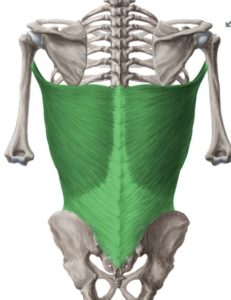One inspiring cue:
Create the feeling of trying to pull yourself forward on your mat by isometrically/energetically dragging your hands back towards your ribs (they won’t actually move).
Why?
There is nothing wrong with pushing yourself up into Cobra pose but, when you use the cue above, you can better activate your latissimus dorsi (the widest muscle in the body) as well as your posterior delts, making you feel more supported and stable in the pose.

One inspiring tip:
Float your hands off the ground while in Cobra pose. Then, activate your lats and posterior delts by creating the same feeling of pulling yourself forward on your mat as described in the cue above. Your hands will be floating so you won’t have the floor to pull against, but you should feel more engagement in your mid and upper back muscles. The low/lumbar spine is already working in Cobra pose, so the idea is to activate the mid back more to assist and stabilize your back and spine.
One inspiring song:
One inspiring quote:
“The joy in life comes from our encounters with new experiences, and hence there is no greater joy than to have an endlessly changing horizon, for each new day to have a new and different sun…don’t settle down and sit in one place. Move around, be nomadic, make each day a new horizon.”
Nutrition nugget:
SUGAR BALANCE
Balancing your blood sugar is an essential step for overall health. Read on, and I will share some easy tips to help control your blood sugar levels.

We can’t be perfect all the time, but as I always say, balance is key! If you like your sweets, or you want a tasty bowl of pasta here and there, what can you do at other times to help control your overall blood sugar? Before we get to my easy tips, let’s review some possible signs of blood sugar imbalance.
Blood sugar imbalance can best be described in the following excerpt from Dr. Will Cole. Dr. Cole is a Functional Medicine Practitioner (FMCP), Doctor of Natural Medicine (DNM), and Doctor of Chiropractic (DC). He is also the host of the podcast “The Art of Being Well” and the bestselling author of Ketotarian, The Inflammation Spectrum, and the New York Times bestseller Intuitive Fasting.
Dr. Cole says, “You probably already know that what you eat directly affects your blood sugar. It’s a pretty simple formula: the more sugar you eat, whether it is in the form of carbohydrates, artificial sweeteners, sugar, or fruit, the more likely your blood sugar is to be elevated. When you eat a food high in carbohydrates, especially without much fiber or fat, the food is quickly converted into glucose in your bloodstream, triggering the release of insulin to take the sugar out of your blood and send it to where you can use it, like in your muscles, or in short-term storage in your liver. But you only need so much glucose and if you eat a lot of sugar-rich and carb-rich foods all the time, your insulin may have trouble keeping up and your blood sugar may stay too high for too long. This puts you on the path to diabetes and other metabolic health problems.”
Symptoms of blood sugar imbalance include:
– fatigue
– headaches
– cravings (especially sugar and caffeine)
– low energy
– mood swings
– increased appetite
– difficulty losing weight
– always thirsty
– have to pee a lot
– getting irritable “hangry” if you miss a meal
So, what can you do?
1) Limit refined carbohydrates (white flour and pasta) and sugars (all of which increase the excretion of calcium from the body). Hello, my BONE HEALTHY FRIENDS!
2) Make sure you are getting enough antioxidants through a colorful diet of vegetables and fruit. More on fruit in a minute.
3) Get a good night’s sleep! “Poor sleep and blood sugar problems go hand in hand. If you are constantly not sleeping well at night, it will impact your blood sugar levels and vice versa. This is because our blood sugar levels rise more with the less sleep we get.” (Dr. Cole)
4) Balance your microbiome. “Those who are overweight or struggle with weight loss resistance – a symptom of underlying metabolic problems – tend to have lower microbiome diversity with lower numbers of beneficial microbiome and higher numbers of harmful bacteria and fungi.” (Dr. Cole)
5) If you love sweets as I do, do your best to eat them after you’ve had a balanced meal of protein, fiber, and healthy fat. Again, you are less likely to spike your blood sugar this way vs. eating sweets on an empty stomach.
Finally, how do you know what fruits and vegetables will spike your glucose?
1) Pay attention to how you feel in the hour or two after you eat them. Are you tired? Hungry again? Food affects all of us differently. A sweet potato or apple may spike your blood sugar and not your friend’s blood sugar.
2) Look at the FIBER! You know I am big on fiber. Subtract the amount of fiber from the number of carbohydrates, and you are left with net carbs: the fewer net carbs, the less of a sugar spike. For example, a medium apple has about 25 grams of carbohydrates and 3 grams of fiber. 25-3=22 net carbs. One cup of blueberries has approximately 21 grams of carbohydrates and 4 grams of fiber. 21-4=17 net carbs. Both fruits have carbohydrates from natural sugar.
If you feel you would like a little more help balancing your blood sugar, you can email me at [email protected] and set up a consultation.
Stay tuned for my next newsletter when I will share a more specific technique for blood sugar balance as well as the many different kinds of sugar and how to know which are better than others.
Enjoy the ever-present Halloween candy and if the sweets make you happy, work on balance and the tips above. Little changes can make a big difference!
For regular Yoga and Nutrition Inspiration, please follow me on Instagram @pamudellyoga.

